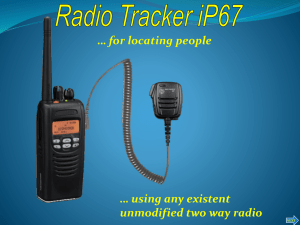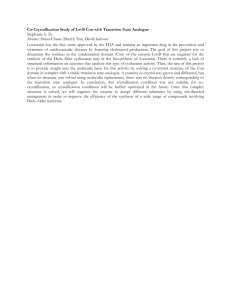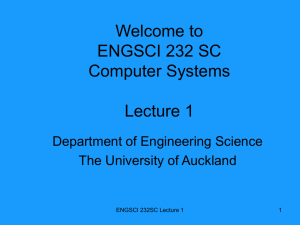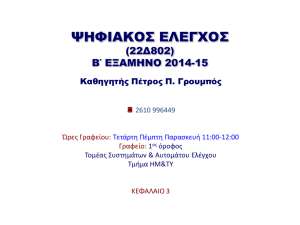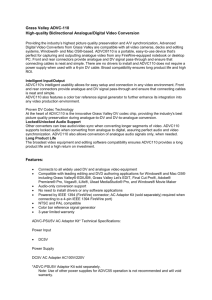Module Guide
advertisement
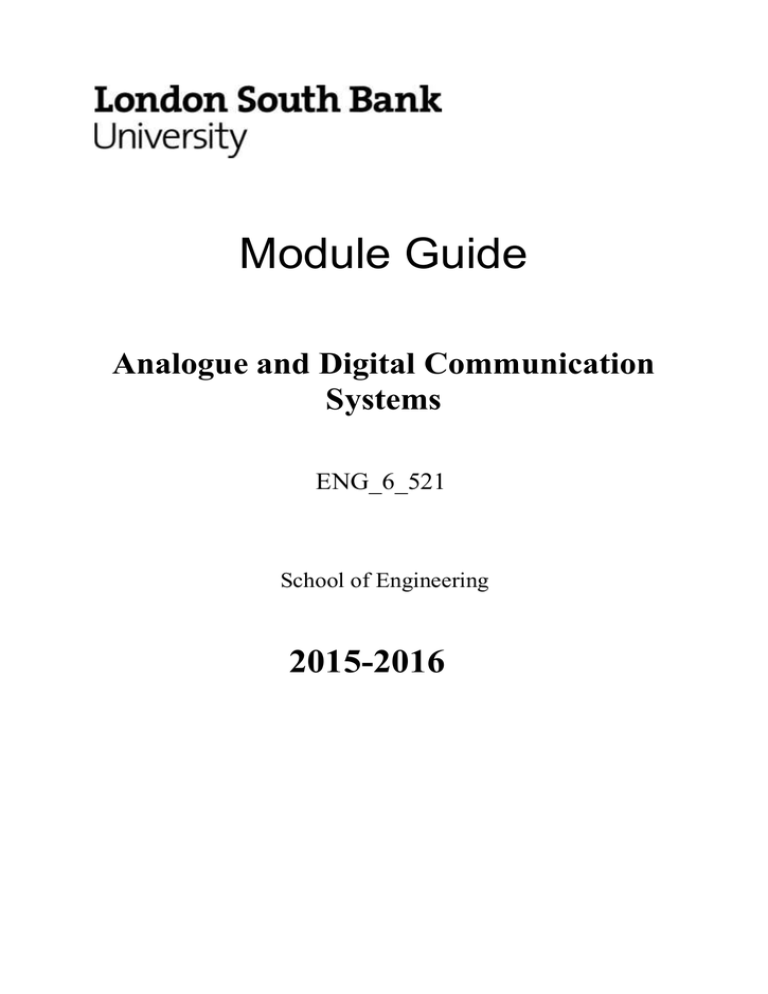
Module Guide Analogue and Digital Communication Systems ENG_6_521 School of Engineering 2015-2016 Analogue and Digital Communication Systems Module Guide Table of Contents 1. 2. 3. 4. Module Details ....................................................................................................................2 Short Description ................................................................................................................2 Aims of the Module ............................................................................................................2 Learning Outcomes .............................................................................................................2 4.1Knowledge and Understanding ....................................................................................................... 2 4.2Intellectual Skills........................................................................................................................... 3 4.3Practical Skills .............................................................................................................................. 3 4.4Transferable Skills......................................................................................................................... 3 5. 6. 7. Assessment of the Module ..................................................................................................3 Feedback .............................................................................................................................4 Introduction to Studying the Module ..................................................................................4 7.1Overview of the Main Content ........................................................................................................ 4 7.2Overview of Types of Classes ........................................................................................................ 4 7.3Importance of Student Self-Managed Learning Time ........................................................................ 4 7.4Employability ............................................................................................................................... 4 8. The Programme of Teaching, Learning and Assessment ...................................................5 9. STUDENT EVALUATION ...............................................................................................5 10. Learning Resources .............................................................................................................5 10.1 Core Materials ...................................................................................................................... 5 10.2 Optional Materials ................................................................................................................ 6 Edited by Ya Bao Page 1 Analogue and Digital Communication Systems Module Guide 1. MODULE DETAILS Module Title: Analogue and Digital Communication Systems Module Level: 6 Module Reference Number: ENG_6_521 Credit Value: 20 Student Study Hours: 200 Contact Hours: 26 hours lectures, 13 hours tutorials, 24 hours workshop Private Study Hours: 137 Pre-requisite Learning (If applicable): Bachelors degree in a relevant subject Co-requisite Modules (If applicable): None Course(s): BEng/MEng Telecommunications Engineering Year and Semester 2015-2016, S2 Module Coordinator: Ya Bao MC Contact Details (Tel, Email, Room) 020 78157588, baoyb@lsbu.ac.uk T701 Teaching Team & Contact Details Dr. JianGuo Zhang (If applicable) 020 78157576, zhangja@lsbu.ac.uk T702 Subject Area: Electronics Summary of Assessment Method: Exam + Coursework 2. SHORT DESCRIPTION This module provides deeper understanding of modern communication theory, communication system performance analysis and a overview of wireless communication technologies and systems. The areas covered are analogue, discrete and digital communication systems, modulation techniques, multiplexing, principles of digital modulation and wireless communication systems. Particular emphasis is given to current digital/wireless communication technologies and architectures, design approaches and applications. 3. 4. AIMS OF THE MODULE To teach the principles of analogue and digital communication system techniques. To teach methods for analogue and digital communication system performance analysis and evaluation. To apply the above methodologies to wireless and mobile communication systems and networks. LEARNING OUTCOMES 4.1 Knowledge and Understanding Edited by Ya Bao Page 2 Analogue and Digital Communication Systems Module Guide To understand the general principles of wired and wireless communication systems. To be familiar with the theories of analogue, digital and wireless communication systems and their application to system design. To analyse and evaluate the system impairments due to transmission channel characteristics in wired and wireless communication systems. To learn various techniques to combat these effects. 4.2 To achieve in-depth knowledge of key concepts of analogue and digital communication systems through mathematical models. To develop the ability to assess system performance according to appropriate performance criteria, and evaluate ways of optimising it. 4.3 Practical Skills To develop laboratory experimentation skills – parameter measurements, experimental data collection and meaningful presentation of measured data. To achieve the abilities of employing general principles of engineering design and practice of analogue and digital communication systems. To be able to use the knowledge acquired in class to solve simple telecommunication engineering problems. To appreciate the limitations of communication device operation and account for these in practical design. 4.4 5. Intellectual Skills Transferable Skills To effectively communicate and critically evaluate observed results in a technical format. To analyse data using complex mathematical techniques obtained in the tutorials and laboratory experiments. To perform teamwork in laboratory environment. To competently maintain a logbook. ASSESSMENT OF THE MODULE The assessment of the module consists of the end of module examination and the coursework. The examination mark contributes 70% the overall module result and the coursework 30%. Edited by Ya Bao Page 3 Analogue and Digital Communication Systems Module Guide End of semester exam is of the duration of 2 hours and covers the materials studied in the whole semester. The coursework consists of TWO coursework assignments based on the laboratory work which will be given to check student’s ability to use the knowledge acquired in class to solve analogue, digital and wireless communications engineering problems. 6. FEEDBACK Feedback will normally be given to students 15 working days after the submission of an assignment. 7. INTRODUCTION TO STUDYING THE MODULE 7.1 Overview of the Main Content This module covers modern communication theory, communication system performance analysis and an introduction of wireless communication technologies and systems. 7.2 Overview of Types of Classes Lectures, tutorials and laboratory workshops These can be classified into two main activities as follows: • Lectures and tutorials will be at the rate of about 3 hour per week. Lectures will cover all the main aspects of the subject matter in the module. You will be given website based handouts to either accompany the module textbook or to complement it when necessary. You are encouraged to find out more about each topic covered for deeper understanding, and to consult your lecturer for more information. • Laboratory sessions, each being for two hours, will be held 12 times during the semester. 7.3 Importance of Student Self-Managed Learning Time As in every module, students are expected to carry out at least 137 hours of independent study throughout the duration of the module. This time should be used to complete the workshop exercises if necessary. 7.4 Employability This module is suitable for students who intend to work in organisations that specify, design, operate and maintain all types of analogue and digital communication devices and systems. The material covered is particularly relevant Edited by Ya Bao Page 4 Analogue and Digital Communication Systems Module Guide to students specialising in the area of consumer electronics where a significant proportion of equipment will have digital electronics and microprocessor components. Students will be equipped with the essential theory and practice enabling them to assess modern trends in the subject and maintain and update their knowledge. Enhancing employability is an important issue this module should not ignore. Using the knowledge acquired in class to solve engineering problems will be stressed through laboratory experiments and tutorials. Some key issues associated to job hunting in the field of telecommunications will be advised. It will prepare graduates with relevant skills for various possible jobs in this field. 8. 9. THE PROGRAMME OF TEACHING, LEARNING AND ASSESSMENT Amplitude and angle modulations Pulse modulation Baseband data transmission Digital band-pass modulation techniques Propagation and channel models of radio signal Wireless transmission technologies Wireless networks and systems STUDENT EVALUATION N/A. This is the first time to run this revised module. . 10. LEARNING RESOURCES 10.1 Core Materials Haykin S, and Moher M, “Introduction to Analog & Digital Communications”, 2nd Edition, Wiley, 2007. Stallings W., “Wireless Communications and Networks” 2nd Edition, PrenticeHall, 2005. ISBN: 0-13-040864-6. Edited by Ya Bao Page 5 Analogue and Digital Communication Systems Module Guide Rappaport T. S., “Wireless Communications: Principles & Practices”, 2nd Edition, Prentice-Hall, 2001. 10.2 Optional Materials Ziemer R E and Tranter W H, “Principles of Communications-Systems, Modulation, and Noise”, 5th Edition, Wiley, 2002. Proakis J G and Salehi M, “Communication Systems Engineering”, 2nd Edition, Prentice Hall, 2002 Couch, L W, “Digital and Analogue Communication Systems”, 6th Edition, Prentice Hall, 2001. Haykin S, “Communication Systems”, 4th Edition, Wiley, 2000. Edited by Ya Bao Page 6


